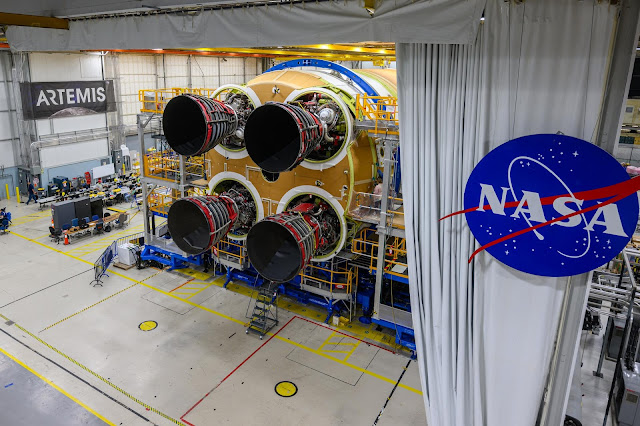NASA Prepares Artemis II Moon Rocket Core Stage for Final Assembly
All four RS-25 engines have been installed onto the Space Launch System (SLS) core stage for NASA’s Artemis II Moon mission. The installation of the engines signals the core stage is nearly finished with assembly and will soon be ready for shipment to NASA’s Kennedy Space Center in Florida. During launch, the rocket’s engines provide more than two million pounds of combined thrust.
The Artemis II RS-25 engines installed on the core stage at NASA's Michoud Assembly Facility in New Orleans. Each engine is the size of a compact car and, together, will create more than two million pounds of thrust during launch. The RS-25 engines create immense pressure that controls the flow of liquid hydrogen and liquid oxygen from the two propellant tanks into each engine's combustion chamber.
NASA and industry partners Aerojet Rocketdyne and Boeing have installed all four RS-25 engines onto the Space Launch System (SLS) rocket core stage for the agency’s Artemis II mission, signaling the core stage is nearing completion. Once complete, the core stage will be shipped to NASA’s Kennedy Space Center in Florida. Aerojet Rocketdyne, an L3Harris Technologies company, is the lead contractor and Boeing is the core stage lead contractor.
These photos show how technicians at NASA’s Michoud Assembly Facility in New Orleans installed the third and fourth RS-25 engines onto the core stage for the agency’s SLS (Space Launch System) rocket that will help power NASA’s first crewed Artemis mission to the Moon. Technicians added the first engine to the SLS core stage on Sept. 11, 2023. The second engine was installed onto the stage Sept. 15 with the third and fourth engines following Sept. 19 and Sept. 20. Engineers consider the engines to be “soft” mated to the rocket stage. Technicians with NASA, Aerojet Rocketdyne, an L3Harris Technologies company and the RS-25 engines lead contractor, along with Boeing, the core stage lead contractor, will now focus efforts on the complex task of fully securing the engines to the stage and integrating the propulsion and electrical systems within the structure.
NASA and its partners have fully secured the four RS-25 engines onto the core stage of the agency’s Space Launch System (SLS) rocket for the Artemis II flight test. The core stage, and its engines, is the backbone of the SLS mega rocket that will power the flight test, the first crewed mission to the Moon under Artemis.
Engineers have begun final integration testing at NASA’s Michoud Assembly Facility in New Orleans, in preparation for acceptance ahead of shipment of the stage to Kennedy Space Center in Florida in the coming months.
“NASA integrated many lessons learned from the first-time build and assembly of the SLS core stage for Artemis I to increase efficiencies during manufacturing and cross-team collaboration with our partners for Artemis II. NASA teams in New Orleans remain focused on assembling and preparing the SLS rocket’s liquid-fueled stage to support the flight.”
—Julie Bassler, Manager of the Stages Office for the SLS Program
The 212-foot-tall core stage includes two massive liquid propellant tanks and four RS-25 engines at its base. For Artemis II, the core stage and its engines act as the powerhouse of the rocket, providing more than two million pounds of thrust for the first eight minutes of flight to send the crew of four astronauts inside NASA’s Orion spacecraft on an approximately 10-day mission around the Moon.
NASA, Aerojet Rocketdyne, an L3Harris Technologies company and the RS-25 engines lead contractor, along with Boeing, the core stage lead contractor, secured the engines to the maze of propulsion and avionics systems within the core stage Oct. 6. In the coming weeks, engineers will perform testing on the entire stage and its avionics and electrical systems, which act as the “brains” of the rocket to help control it during flight.
Once testing of the stage is complete and the hardware passes its acceptance review, the core stage will be readied for shipping to Kennedy via the agency’s Pegasus barge, based at Michoud.
As teams prepare the core stage for Artemis II, rocket hardware is also under construction on our factory floor for Artemis III, IV, and V that will help send the future Artemis astronauts to the lunar South Pole.
The engines were first soft mated one by one onto the stage beginning in early September. The last RS-25 engine was structurally installed onto the stage Sept. 20. Installing the four engines is a multi-step, collaborative process for NASA, Boeing, and Aerojet Rocketdyne.
Following the initial structural connections of the individual engines, securing and outfitting all four engines to the stage is the lengthiest part of the engine assembly process and includes securing the thrust vector control actuators, ancillary interfaces, and remaining bolts before multiple tests and checkouts.
All major hardware elements for the SLS rocket that will launch Artemis II are either complete or in progress. The major components for the rocket’s two solid rocket boosters are at Kennedy. The rocket’s two adapters, produced at Marshall, along with the rocket’s upper stage, currently at lead contractor United Launch Alliance’s facility in Florida near Kennedy, will be prepared for shipment in the spring.
NASA is working to land the first woman and first person of color on the Moon under Artemis. SLS is part of NASA’s backbone for deep space exploration, along with Orion and the Gateway in orbit around the Moon, and commercial human landing systems. SLS is the only rocket that can send Orion, astronauts, and supplies to the Moon in a single mission.
Learn more about the Artemis II Mission:
https://www.nasa.gov/artemis-ii
Learn more about SLS: nasa.gov/sls
Image Credit: NASA
Story Credit: Megan Carter
Release Date: Oct. 13, 2023
#NASA #Space #Moon #NASAArtemis #ArtemisProgram #ArtemisII #NASASLS #SpaceLaunchSystem #SLS #CoreStage #RS25Engines #AerojetRocketdyne #Boeing #DeepSpace #Astronauts #MoonToMars #Science #Engineering #SpaceTechnology #SpaceExploration #SolarSystem #MSFC #NASAMichoud #MAF #NewOrleans #Louisiana #UnitedStates #STEM #Education












.jpg)





.jpg)
V1.jpg)
V2.jpg)
V3.jpg)
V4.jpg)
V5.jpg)
V6.jpg)
V7.jpg)
V8.jpg)







